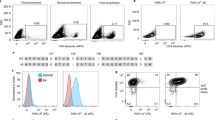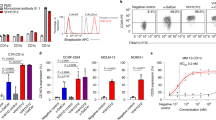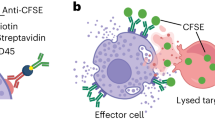Abstract
The CD4 subset of cells displays helper/inducer activity and recognizes class II antigens of the major histocompatibility complex (MHC), while the CD8 subset recognizes class I MHC antigens and exhibits cytotoxic or suppressor function1–3. Considerable functional as well as corresponding phenotypic heterogeneity exists within the two major T cell subsets4–8. Although the CD8+ population contains pre-cytotoxic, cytotoxic, pre-suppressor and suppressor effector T cells, these distinctions still rest largely on the use of functional assays. Attempts have been made to define the CD8+ precursor of the killer cell with new monoclonal antibodies9. But more precise phenotypic distinctions between the functional subpopulations within CD8+ cells will be needed. We have now developed a monoclonal antibody, anti-S6F1 which can distinguish killer effector and suppressor effector cells in CD8 lymphocyte populations. The cell-surface structure defined by this antibody comprises two glycoproteins with relative molecular mass (Mr) 180K and 95K respectively. Also sequential immunoprecipitation studies and two dimensional gel electrophoresis indicate that anti-S6F1 recognizes a novel epitope on the LFA-1 antigen10–12.
This is a preview of subscription content, access via your institution
Access options
Subscribe to this journal
Receive 51 print issues and online access
$199.00 per year
only $3.90 per issue
Buy this article
- Purchase on Springer Link
- Instant access to full article PDF
Prices may be subject to local taxes which are calculated during checkout
Similar content being viewed by others
References
1. Reinherz, E. L. & Schlossman, S. F. New Engl. J. Med. 303, 370-373 (1980). 2. Meuer, S. C., Schlossman, S. F. & Reinherz, E. L. Proc. natn. Acad. Sci. U.S.A. 79,4395-4399 (1982). 3. Krensky, A. M. et al. J. Immun. 129, 2001-2003 (1982). 4. Morimoto, C., Letvin, N. L., Distaso, J. A., Aldrich, W. R. & Schlossman, S. F. J. Immun. 134, 1508-1515 (1985). 5. Morimoto, C. et al. J. Immun. 134, 3762-3765 (1985). 6. Smith, S. H., Brown, M. H., Rowe, D., Callanard, R. E. & Beverley, P. C. L. Immunology 58, 63-70 (1986). 7. Reinherz, E. L., Hussey, R. E. & Schlossman, S. F. Immunogenetics 11, 421-426 (1980). 8. Gatenby, P. A., Kotzin, B. L., Kansas, G. S. & Engleman, E. G. J. exp. Med. 156,55-67 (1982). 9. Clement, L. T., Grossi, C. E. & Gartland, G. L. J. Immun. 133, 2461-2468 (1984). 10. Tedder, T. F., Schmidt, R. E., Rudd, C. E., Kornacki, M. M., Ritz, J. & Schlossman, S. F. Eur. J. Immun. 16, 1539-1543 (1986). 11. Sanchez-Madrid, F., Nagy, J., Robbins, E., Simon, P. & Springer, T. A. /. exp. Med. 158, 1785-1803 (1983). 12. Sanchez-Madrid, F. et al. Proc. natn. Acad. Sci. U.S.A. 79, 7489-7493 (1982). 13. Hubbard, A. L. & Cohn, Z. A. Biochemical analysis of membranes (ed. Maddy, A. H.) 427-501 (Chapman and Hall, London, 1976). 14. Laemmli, U. K. Nature 267, 680-684 (1970). 15. O'Farrell, P. L., Goldman, H. J. M. & O'Farrell, P. H. Cell 12, 1133-1142 (1977). 16. Rudd, C. E., Bodmer, J. G., Bodmer, W. F. & Crumpton, M. J. J. biol. Chem. 200,1927-1936 (1985).
Author information
Authors and Affiliations
Rights and permissions
About this article
Cite this article
Morimoto, C., Rudd, C., Letvin, N. et al. A novel epitope of the LFA-1 antigen which can distinguish killer effector and suppressor cells in human CD8 cells. Nature 330, 479–482 (1987). https://doi.org/10.1038/330479a0
Received:
Accepted:
Issue Date:
DOI: https://doi.org/10.1038/330479a0
This article is cited by
-
Rheumatoid meningitis developed in patient with stable rheumatoid arthritis and myasthenia gravis—detailed analysis of intracranial inflammation using flow cytometry
Journal of Neuroinflammation (2018)
-
A monoclonal antibody against lymphocyte function-associated antigen-1 decreases HIV-1 replication by inducing the secretion of an antiviral soluble factor
Virology Journal (2013)
-
Differences in systemic and central nervous system cellular immunity relevant to relapsing–remitting multiple sclerosis
Journal of Neurology (2005)
-
Blood and alveolar lymphocyte subsets in pulmonary cytomegalovirus infection after lung transplantation
BMC Infectious Diseases (2001)
-
Analysis of bone marrow and peripheral blood immunoregulatory lymphocytes in patients with myelodysplastic syndrome
Annals of Hematology (1995)
Comments
By submitting a comment you agree to abide by our Terms and Community Guidelines. If you find something abusive or that does not comply with our terms or guidelines please flag it as inappropriate.



